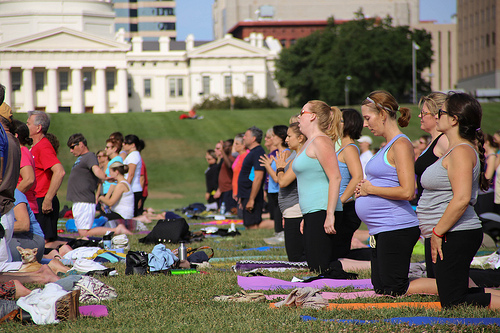Health Education Is About Lifestyle Changes

Health education has evolved over the years. It’s no longer jus about preventing illnesses, but also about promoting healthy lifestyle changes.
Nowadays, health education includes promoting physical activity for all, healthy school lunches, less alcohol intake, and preventing smoking, for example.
It focuses on educating people about their environment, including how to make the best out of it and how to improve it.
The concept of Health Education
According to the World Health Organization (WHO), health education “is any combination of learning experiences designed to help individuals and communities improve their health, by increasing their knowledge or influencing their attitudes.”
Most importantly, its main goal is to teach people how to take care of themselves, but also to be healthier overall.
Our health is connected to our environment, our healthcare system, and economical means. Nonetheless, it’s also involved in our lifestyle and our biology. All of these factors should be considered when reinforcing health education. Likewise, the end goal should be to include healthier habits in our everyday lives.
Health education is about preventing and educating people, their families, social groups, etc. It’s not only about preventing diseases, but it’s also about creating healthier habits.
This can be done through education, not only at schools but also at organizations dedicated to this. These institutions work on developing spaces of reflection where communities can build and develop skills to complement and reinforce best practices.

Health Education for general healthcare
Above all, improving people’s health requires preventing diseases and promoting healthy habits.
Prevention
This aims to avoid health-related issues through risk assessment and control. There are three levels of prevention:
- Primary prevention. It’s for the general public and includes prevention campaigns. In other words, anti-smoking ads, vaccinations campaigns, cancer screenings, education on sex and hygiene. It also addresses environmental risks, healthy eating habits to avoid obesity, physical and mental activity sessions, and rest.
- Secondary prevention. It’s about solving problems as soon as possible. It aims to detect any health issues in the early stages, establishing ways to solve or prevent them from spreading. It includes early screenings and treatments.
- Tertiary prevention. Its main focus is therapy sessions and rehabilitation. Similarly, it can relay social rehabilitation.

Promoting healthy habits
Promoting healthy habits can help people adopt healthier lifestyles. Most importantly, its main goal is to help people have more control over their health by being a part of it.
Health promotion can be done through many social and environmental activities, focused on benefiting and protecting people’s health and quality of life. It’s not just about the aftermath of a disease, but also on treating the root of the problem.
According to the WHO, health promotion relies on stronger political measures to emphasize the importance of health as well as provide health education to all. It’s also about healthy and sensitive urban planning, which needs to address the communities and supply them with health care centers.

Final thoughts
Health education requires the involvement of all people, together with all institutions and agents available. This group effort is essential.
Likewise, every family needs to promote good health education at home, making each person accountable for their own health. The school system also needs to promote and reinforce these health values.
In addition, there should also be organizations that promote health education through their activities and social gatherings.
Health education has evolved over the years. It’s no longer jus about preventing illnesses, but also about promoting healthy lifestyle changes.
Nowadays, health education includes promoting physical activity for all, healthy school lunches, less alcohol intake, and preventing smoking, for example.
It focuses on educating people about their environment, including how to make the best out of it and how to improve it.
The concept of Health Education
According to the World Health Organization (WHO), health education “is any combination of learning experiences designed to help individuals and communities improve their health, by increasing their knowledge or influencing their attitudes.”
Most importantly, its main goal is to teach people how to take care of themselves, but also to be healthier overall.
Our health is connected to our environment, our healthcare system, and economical means. Nonetheless, it’s also involved in our lifestyle and our biology. All of these factors should be considered when reinforcing health education. Likewise, the end goal should be to include healthier habits in our everyday lives.
Health education is about preventing and educating people, their families, social groups, etc. It’s not only about preventing diseases, but it’s also about creating healthier habits.
This can be done through education, not only at schools but also at organizations dedicated to this. These institutions work on developing spaces of reflection where communities can build and develop skills to complement and reinforce best practices.

Health Education for general healthcare
Above all, improving people’s health requires preventing diseases and promoting healthy habits.
Prevention
This aims to avoid health-related issues through risk assessment and control. There are three levels of prevention:
- Primary prevention. It’s for the general public and includes prevention campaigns. In other words, anti-smoking ads, vaccinations campaigns, cancer screenings, education on sex and hygiene. It also addresses environmental risks, healthy eating habits to avoid obesity, physical and mental activity sessions, and rest.
- Secondary prevention. It’s about solving problems as soon as possible. It aims to detect any health issues in the early stages, establishing ways to solve or prevent them from spreading. It includes early screenings and treatments.
- Tertiary prevention. Its main focus is therapy sessions and rehabilitation. Similarly, it can relay social rehabilitation.

Promoting healthy habits
Promoting healthy habits can help people adopt healthier lifestyles. Most importantly, its main goal is to help people have more control over their health by being a part of it.
Health promotion can be done through many social and environmental activities, focused on benefiting and protecting people’s health and quality of life. It’s not just about the aftermath of a disease, but also on treating the root of the problem.
According to the WHO, health promotion relies on stronger political measures to emphasize the importance of health as well as provide health education to all. It’s also about healthy and sensitive urban planning, which needs to address the communities and supply them with health care centers.

Final thoughts
Health education requires the involvement of all people, together with all institutions and agents available. This group effort is essential.
Likewise, every family needs to promote good health education at home, making each person accountable for their own health. The school system also needs to promote and reinforce these health values.
In addition, there should also be organizations that promote health education through their activities and social gatherings.
All cited sources were thoroughly reviewed by our team to ensure their quality, reliability, currency, and validity. The bibliography of this article was considered reliable and of academic or scientific accuracy.
- Perea Quesada, R. (2002). La educación para la salud, reto de nuestro tiempo. Recuperado de http://e-spacio.uned.es/fez/eserv/bibliuned:EducacionXXI-F118F1B1-20B0-6C6D-8F91-9988F26282B4/Documento.pdf
- Restrepo, H. (2001). Promoción de la salud: cómo construir una vida saludable. Organización panamericana de la salud. OMS
This text is provided for informational purposes only and does not replace consultation with a professional. If in doubt, consult your specialist.








